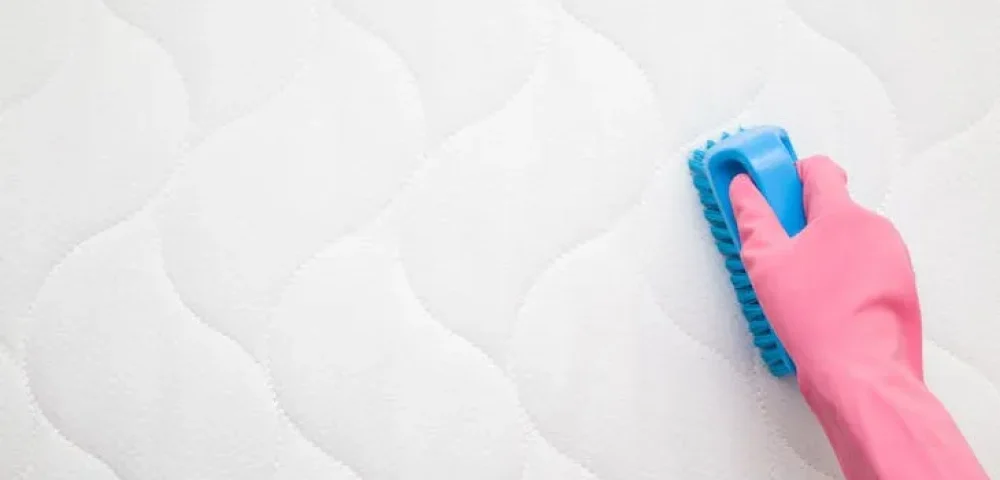Accidents happen, and one of the more challenging ones to deal with is urine on a mattress. Whether it’s a result of a child’s bedwetting or a pet mishap, the key to mitigating damage lies in a prompt and proper cleaning approach.
The makeup of your mattress and the properties of urine are crucial for effective cleaning. Techniques and materials for cleaning urine from a mattress may vary, but an immediate response can prevent long-term damage and odors.
There are several effective household solutions for removing urine from mattresses, including the use of vinegar, baking soda, and hydrogen peroxide. A step-by-step process involving these items can help remove both stains and odors without leaving behind harsh chemical residues or damaging the mattress material.
Beyond immediate cleanup, maintaining a clean and dry mattress is just as important for extending the life of the mattress and ensuring a healthy sleeping environment.
Page Contents
- 1 Mattress Materials and Maintenance
- 2 Immediate Actions After an Accident
- 3 Cleaning Solutions for Urine Removal
- 4 Step-by-Step Cleaning Process
- 5 Eliminating Odor and Stains
- 6 Drying and Airing the Mattress
- 7 Preventative Measures for Future Incidents
- 8 Considerations for Specific Types of Urine
- 9 Additional Mattress Care Tips
- 10 Professional Mattress Cleaning Options
- 11 Health and Safety Considerations
- 12 FAQs
- 13 Conclusion
Key Takeaways
- Acting quickly when an incident occurs reduces the chance of a stain or odor.
- Common household items can effectively clean and deodorize the mattress.
- Regular mattress maintenance prevents future incidents and preserves mattress integrity.
Mattress Materials and Maintenance
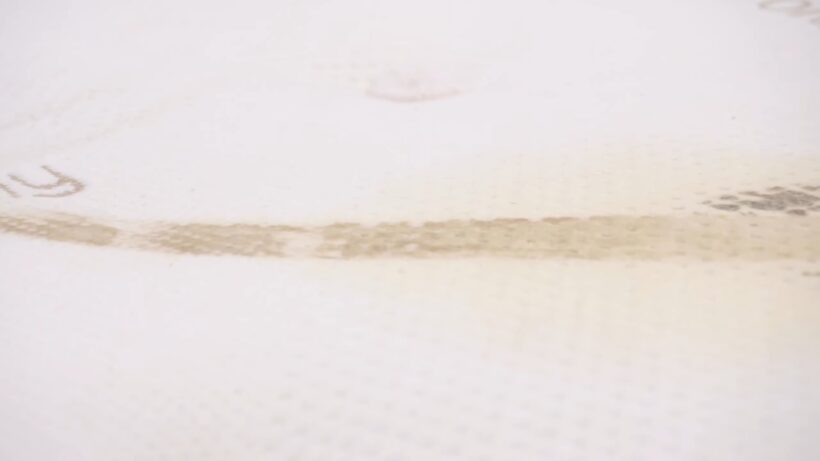
Selecting the right mattress and protecting it with a waterproof protector are vital for its longevity and your sleep quality. These components are significant in sleep science, keeping the mattress in top condition and ensuring a healthy sleeping environment.
Types of Mattresses
Mattresses come in various materials, which have distinctive qualities affecting their absorbency and how they should be maintained.
The most common types include:
- Innerspring: Durable and bouncy with a high level of support.
- Memory foam: Known for its pressure relief and body-contouring abilities. Memory foam mattresses are dense, making them less breathable but highly resilient.
- Latex: Recognized for its eco-friendliness and breathability, providing a cooler sleeping surface than memory foam.
- Hybrid: Combines layers of foam with innerspring coils, offering a balance of comfort and support.
Each material responds differently to moisture and stains, with memory foam being particularly susceptible to absorbing liquids due to its dense structure.
Importance of a Waterproof Mattress Protector
A waterproof mattress protector is an essential accessory for any mattress as it serves a dual purpose:
- Protects the mattress from spills and stains: Keeping the mattress dry helps prevent the accumulation of mold, mildew, and unpleasant odors that can be challenging to remove once set in.
- Prolongs the mattress’s life: By shielding it from moisture and bodily fluids, which can break down the materials over time.
For memory foam mattresses, which cannot be washed, a waterproof protector is especially crucial in maintaining the integrity of the foam. Additionally, for individuals concerned with sleep science, a clean and well-maintained mattress contributes to better sleep hygiene.
Immediate Actions After an Accident
When an accident occurs, the priority is to quickly remove excess moisture and blot the wet area to minimize mattress damage. Swift action can prevent the urine from soaking deeply into the mattress fibers.
Removing Excess Moisture
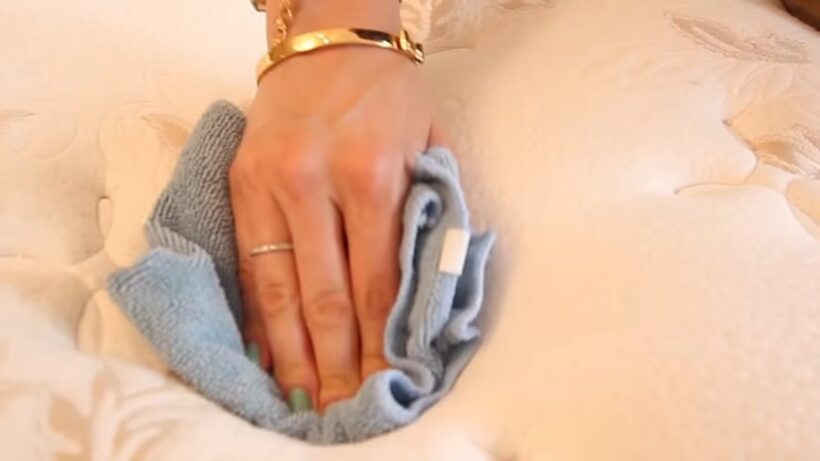
One should first remove any bedding that has been affected to stop the spread of moisture. Then, using absorbent towels or paper towels, they should gently press down on the accident area to absorb as much water or fresh pee as possible.
It is crucial that they avoid rubbing the spot, as this can cause the liquid to spread and embed further into the mattress.
Blotting the Wet Area
Once the excess moisture has been lifted, to blot the wet area, they should take a clean, dry towel and apply pressure firmly to the spot. The goal is for the towels to draw out moisture from the mattress. They might need to repeat this process with fresh towels several times until no more liquid is absorbed.
Cleaning Solutions for Urine Removal
Effective urine removal from a mattress requires specific solutions to break down the odors and stains. Both homemade and store-bought cleaners can be employed to tackle this issue.
Homemade Cleaning Solutions
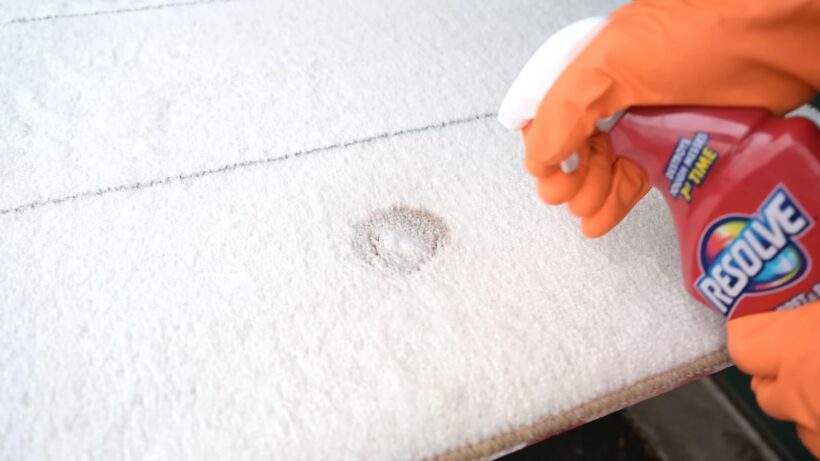
Homemade solutions are economical and can be made with common household items. Baking soda is a key player due to its natural deodorizing properties. A typical homemade solution could include a mixture of 8 ounces of hydrogen peroxide, 3 tablespoons of baking soda, and a few drops of dish soap or liquid detergent.
This mixture should be added to a spray bottle and applied generously to the stained area. For a refreshing scent, a few drops of essential oil can be mixed into the vinegar solution. It is crucial to allow the solution to fully dry, often resulting in a residue of baking soda that can then be vacuumed up.
Store-Bought Cleaners

When opting for store-bought cleaners, it is advisable to choose enzyme cleaners specifically designed for pet stains and odors, as they contain special biological enzymes that break down the urine molecules. They should be used according to the manufacturer’s instructions.
It is important to avoid products that contain bleach, as it can damage the mattress material and only masks the smell temporarily. Instead, look for cleaning products labeled as safe for use on mattresses and effective against urine odors.
Remember to always spot test a small, inconspicuous area first to ensure the cleaner does not discolor or damage the mattress.
Step-by-Step Cleaning Process
Cleaning urine from a mattress can be straightforward with the right approach. Below, the method is broken down into clear steps, focusing on applying a cleaning solution and the proper technique to scrub the mattress effectively.
Applying the Cleaning Solution

Firstly, remove all bedding and ensure the mattress is bare. For the cleaning solution, mix equal parts of cold water and white vinegar in a spray bottle. Spray the affected area generously, but avoid saturating the mattress.
For a store-bought solution, select a product specifically designed to remove pee from a mattress ensuring it’s pet and child-safe if necessary.
Scrubbing the Mattress

After the solution has had time to work, take a clean towel or cloth and blot the area to absorb excess moisture.
Next, use a soft-bristle brush to gently scrub the surface where the urine was present. This helps to work the solution deeper into the fibers and further loosen any residual matter.
It’s important to scrub gently to avoid damaging the mattress. Once scrubbed, blot again with a dry towel to remove the lifted dirt and cleaning solution.
Eliminating Odor and Stains
When urine accidents occur, it’s crucial to tackle both the stain and the odor swiftly. Common household items such as distilled white vinegar and baking soda are often effective in neutralizing odors and lifting stains, restoring the mattress to a fresh state.
Dealing with Persistent Smells
One can neutralize persistent pee smells by using a solution of distilled white vinegar and water. This natural deodorizer breaks down the odor molecules without damaging the mattress material. Here’s a step-by-step approach:
- Prepare the Solution: Mix equal parts of distilled white vinegar and water in a spray bottle.
- Apply the Solution: Generously spray the affected area, ensuring the solution penetrates the mattress surface.
- Blot the Area: Using a clean towel, blot out excess moisture.
- Add Baking Soda: Sprinkle a generous amount of baking soda over the area, and leave it on for at least 8 hours to absorb remaining smells.
- Vacuum: After the waiting period, vacuum up the baking soda.
Addressing Tough Stains
Especially tough pee stains may require a more concentrated approach. Hydrogen peroxide can be an effective stain remover when used cautiously. The steps below should be followed carefully to avoid damage to the mattress materials:
- Create a Stain-Removing Paste:
- Combine 3 tablespoons of baking soda
- Add a small amount of hydrogen peroxide
- Stir in a drop of liquid dish soap to form a paste
- Apply the Paste: Spread the paste directly on the stain and let it sit until it dries completely.
- Scrape Off Dry Residue: Once the paste is dry, scrape off the residue.
- Vacuum the Area: Run a vacuum over the spot to remove all remaining residue.
- Inspect: Review the area to ensure the stain has lifted; repeat the process if necessary.
By diligently addressing both smell and stains, one ensures that their mattress remains clean and odor-free.
Drying and Airing the Mattress
After thoroughly cleaning a mattress that has been wetted, it’s critical to dry it completely to prevent mold and mildew growth. The following subsections detail techniques and methods to ensure the mattress is dry and ready for use as quickly and effectively as possible.
After Cleaning Drying Techniques
To begin the drying process, one should gently press clean towels into the mattress surface to absorb excess moisture. Subsequently, employing a hairdryer set on a cool setting can expedite the drying while reducing the risks of heat damage.
It’s imperative to keep the hairdryer moving in a sweeping motion over the damp area to distribute air evenly and avoid concentrating heat in one spot.
Natural Air-Drying Methods
When possible, natural air-drying is the most effective way to dry a mattress after wetting the bed. Placing the mattress outdoors in the sun can greatly accelerate drying, as the sunlight naturally sanitizes and helps to eliminate any residual odors.
If the outdoor option isn’t feasible, one can improve indoor air circulation by opening windows or using fans to create a cross breeze. The enhancement of air flow around the mattress is crucial for evaporating moisture without the need for additional heat.
Preventative Measures for Future Incidents

To mitigate the risks of future urine accidents, certain proactive steps should be taken. Focusing on both mattress protection and routine care can preserve the mattress’s condition and extend its lifespan.
Using Mattress Covers
Investing in a waterproof mattress protector is a key strategy. It acts as a barrier against spills and can be particularly effective for preventing pet urine stains.
For beds frequented by pets or children, a washable, waterproof mattress protector is ideal, as it can be easily removed and cleaned, maintaining hygiene without compromising the mattress underneath.
Routine Maintenance Tips
Incorporating routine maintenance into the care regimen for one’s bedding can also forestall mattress damage. Regularly wash sheets to remove any contaminants that might seep through to the mattress.
Checking the mattress protector periodically for wear or damage ensures that it remains effective. By preventing the accumulation of moisture and debris, one not only prevents stubborn mattress stains but also contributes to a healthier sleep environment.
Considerations for Specific Types of Urine
When urine accidents happen on a mattress, treating them effectively requires understanding the differences between pet and human urine in composition and scent. The correct approach can help eliminate odors and stains, ensuring a clean and hygienic sleeping environment.
Addressing Pet Urine Challenges
Pet urine, like cat pee, often contains a higher concentration of proteins and ammonia which can result in a stronger odor and more persistent stains.
Specially formulated enzymatic cleaners work by breaking down these proteins, effectively neutralizing pet urine odors. It is crucial to blot the area thoroughly with a clean towel before applying these cleaners to maximize absorption.
Treating Human Accidents
Human urine stains, such as those from bedwetting, typically require immediate attention to prevent the urine from setting into the mattress.
An effective method includes a combination of absorbing the liquid, typically with a clean towel, and treating the area with natural solutions like vinegar and baking soda to dissolve and deodorize the remnants. It is essential to allow the mattress to dry completely to thwart the growth of mold or mildew.
Additional Mattress Care Tips
Maintaining a clean mattress extends beyond addressing accidental spills and stains, it embraces regular upkeep to ensure a hygienic sleep environment.
Incorporating consistent cleaning habits not only promotes longevity of the mattress but also ensures a healthier sleeping area by minimizing exposure to common bedroom allergens.
Regular Vacuuming
Vacuuming a mattress is an essential routine that should not be overlooked. It is the first line of defense against a build-up of dust mites and other particulate matter. Use the upholstery attachment of a vacuum cleaner to ensure thorough cleaning.
It’s advisable to vacuum the mattress once in three and six months or more often in case of high allergy sensitivity. This practice helps to remove dust mites, pet hair, and other potential allergens that can accumulate within the fabric and upper layers of the mattress.
Dealing with Persistent Allergens
Even with regular vacuuming, mattresses can harbor allergens that may provoke symptoms in sensitive individuals. For a more in-depth cleaning, an individual may consider using specially designed mattress encasements which can protect against allergens, bed bugs, and other irritants.
These covers are made from fabrics that are impermeable to allergens yet still breathable for comfort. It is also beneficial to wash bedding frequently in hot water to kill any lingering dust mites and to consider the use of a dehumidifier, as dust mites thrive in humid environments.
Professional Mattress Cleaning Options
For those tough urine stains and odors that home remedies cannot tackle, professional mattress cleaning options offer expertise and equipment to rejuvenate your mattress.
When to Seek Professional Help
They should consider professional cleaning when the urine has penetrated deeply into the mattress, causing persistent odors and stains that at-home methods fail to remove. This is often the case with repeated incidents or when the stain has been left untreated for an extended period.
Professional Cleaning Methods
When it comes to ensuring the cleanliness and longevity of various items, especially mattresses, professional cleaning methods stand out for their efficiency and effectiveness. Professional cleaners employ a variety of advanced techniques and specialized products to tackle different types of stains, odors, and hygiene concerns.
Steam Cleaning
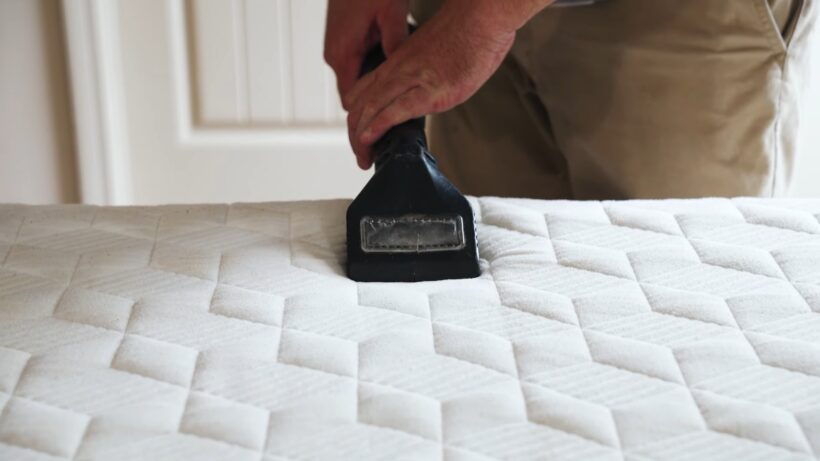
One of the most preferred methods used by professionals is steam cleaning. This process involves using high-temperature steam to penetrate deep into the fibers of the mattress. The heat from the steam not only helps in loosening and lifting dirt and debris but also plays a crucial role in sanitizing the surface.
This is particularly effective in eliminating allergens, dust mites, and other microscopic organisms that can be harmful to health. Steam cleaning is a versatile method, suitable for a variety of fabrics and materials, making it a go-to choice for many professionals.
Enzyme-Based Cleaners
Professional cleaning services often utilize enzyme-based cleaners, especially when dealing with stubborn organic stains and odors. These cleaners contain specific enzymes that break down organic matter such as urine, sweat, and blood, which are common culprits for unpleasant odors in mattresses.
By targeting the proteins in these substances, enzyme cleaners can effectively neutralize odors at their source, rather than merely masking them. This makes them an excellent option for restoring hygiene and freshness.
UV Light Treatment
In addition to traditional cleaning methods, many professional services have begun incorporating UV light treatment into their cleaning processes. UV light is known for its ability to kill bacteria, viruses, and dust mites without the use of chemicals.
This method involves exposing the mattress to a specific wavelength of UV light, which penetrates the surface and eradicates harmful microorganisms. This is particularly beneficial for individuals with allergies or respiratory issues, as it ensures a more hygienic sleeping environment.
Customized Cleaning Approaches
Professional cleaners understand that different materials and types of soiling require different approaches. Therefore, they often assess the situation and decide on the most appropriate method.
For instance, delicate fabrics might need a gentler approach compared to more robust materials. Additionally, some stains may require pre-treatment with specific solutions before the main cleaning process.
Health and Safety Considerations

When cleaning urine from a mattress, it is vital to consider the use of non-toxic substances and to create a sleep environment that promotes healthfulness and reduces stress.
Avoiding Toxic Chemicals
One should opt for safe, household products rather than harsh chemicals that could introduce toxic substances into the bedroom.
The use of white vinegar and baking soda, for example, offers a non-toxic alternative for effectively removing urine stains and odors.
It is wise to wear rubber gloves during the cleaning process to avoid direct contact with urine, which may contain harmful bacteria.
Ensuring a Healthy Sleep Environment
To promote a healthy sleep environment, adequate removal of the urine smell is necessary, as persistent odors can make a sleeping area feel unclean and smellier, increasing stress levels.
A thorough cleaning, as per the mattress’s warranty guidelines, is recommended to not only maintain the mattress’s integrity but also to ensure the longevity of a healthy, hygienic place to rest.
Once the mattress is clean and dry, cover it with a protective barrier to guard against future accidents and contaminants.
FAQs
How long does it take to get pee out of a mattress?
It can take several hours to a full day to completely remove pee from a mattress, depending on the extent of the stain and the drying process used.
Does urine ruin memory foam?
Urine can damage memory foam if not cleaned promptly. It can cause odors, staining, and in some cases, break down the foam material.
How do you clean your bed after you pee in it?
Blot up excess urine, apply an enzyme-based cleaner to break down the urine, let it sit for at least 15 minutes, then blot again. Rinse with cold water, blot out as much moisture as possible, and allow the mattress to air dry completely.
Is a mattress ruined if it gets wet?
A mattress is not necessarily ruined if it gets wet, but it needs to be dried thoroughly as soon as possible. Prolonged moisture can lead to mold, mildew, and deterioration of materials.
How do you dry a wet bed fast?
Remove bedding, blot excess moisture, use a fan or hairdryer on a cool setting, and if possible, expose the mattress to sunlight. Dehumidifiers and air movers can also speed up the drying process.
Conclusion
Removing pee from a mattress may seem daunting, but with the right approach, it’s entirely manageable. By using common household items like vinegar, baking soda, and laundry detergent, you can effectively tackle both the stain and the odor.
The key is to act quickly and allow the mattress to dry completely to prevent mold growth. Regular maintenance, such as using a mattress protector and airing out your mattress, can also play a crucial role in keeping your bed clean and hygienic.
We are certain you will find this insight of ours interesting and informative.
If you are interested in reading more interesting subjects, visit our website.
Also Read:
- Main Causes of Nutrient Deficiencies and Effective Solutions
- Do You Have Underboob Rashes? Find Out What Causes…
- Can You Get a Pedicure if You Have Toenail Fungus?…
- Get Rid Of Armpit Fat In A Jiffy With These 7…
- Get Rid of Lip Pimples Swollen, Big, Painful, Upper,…
- Does Peripheral Neuropathy Pain Get Worse in Cold Weather?

